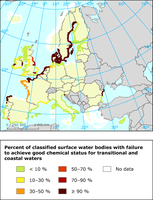
The figure shows the change in yearly cumulated area of the Greenland ice sheet and it's melt during the period 1979 to 2011 in percentage relative to area in 1979=100. The linear trend 1979–2011 is included.

The figure shows the mass balance of the Greenland ice sheet from mass budget calculations.

-

Concentrations are expressed as a median of annual mean concentrations. Up to three-year gaps of missing values have been interpolated or extrapolated. Only complete series with no missing values after this interpolation/extrapolation are included. The number of time series/river stations is shown in parentheses. The trend for 1992 to 2010 for each of the ecological quality classes has been linearly extended to 2027 — or when the concentration level becomes negative.

-

-

The graphs illustrate the chemical status of transitional and coastal water bodies as percentage of water bodies in poor and good chemical status, by count of water bodies.

-

The graphs illustrate the chemical status of river and lake water bodies as percentage of water bodies in poor and good chemical status, by count of water bodies.

-

The graphs illustrate the chemical status of groundwater, Percentage of groundwater bodies in poor and good status, by area.

-

The graphs illustrate the ecological status of lake water bodies (a) and percentage of lake water bodies affected by diffuse pollution and hydromorphology pressures

The graphs illustrate the ecological status of river water bodies (a) and percentage of river water bodies affected by diffuse pollution and hydromorphology pressures

-

The graphs illustrate the designation of heavily and artificial water bodies

-

Production is defined under Article 1(5) of the Montreal Protocol as production minus the amount destroyed minus the amount entirely used as feedstock in the manufacture of other chemicals.

Extent of river basin districts

-